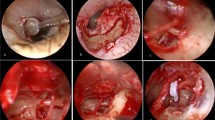Abstract
Background
Although, both the microscopic and endoscopic stapes surgery have claimed a parallel audiological outcome, the comparison between two standard endoscopes (4 mm and 3 mm) in endoscopic stapedotomy is not well documented. We have compared the clinical utility and audiological outcomes of the 3 mm and 4 mm rigid nasal endoscopes in the primary endoscopic stapedotomy.
Materials and methods
This is a retrospective study conducted in the Department of Otorhinolaryngology between June 2015 and May 2018. Total 46 patients of primary otosclerosis had undergone endoscopic stapedotomy where 3 mm and 4 mm nasal endoscopes have been used in 22 (group A) and 24 patients (group B) respectively. The preoperative, intraoperative and postoperative surgical findings including the hearing outcomes were compared between the two groups.
Results
One patient (4.5%) in group A and 6 (25%) patients in group B required canaloplasty (p = 0.00, χ2 test) and 7 (31.18%) patients in group A and 18(75%) in group B had required curettage of the bony canal wall (p = 0.04, χ2 test). There was no significant difference in the air–bone gap between the two groups (p = 0.85).
Conclusion
Both 3 mm and 4 mm nasal endoscopes can be successfully used in the endoscopic stapedotomy providing a parallel visual field. Although, comparable results can be obtained in preserving the chorda tympani nerve, tympanic membrane, facial nerve, and postoperative giddiness including the audiological outcomes, the requirement of the canaloplasty and curettage of posterior bony canal can be significantly reduced in patients operated with 3 mm nasal endoscope, especially in patients with narrow/over angulated external auditory canal.



Similar content being viewed by others
References
Hunter JB, Rivas A (2016) Outcomes following endoscopic stapes surgery. Otolaryngol Clin North Am 49:1215–1225
Kojima H, Komori M, Chikazawa S et al (2014) Comparison between endoscopic and microscopic stapes surgery. Laryngoscope 124:266–271
Iannella G, Marcotullio D, Re M et al (2017) Endoscopic vs microscopic approach in stapes surgery: advantages in the middle ear structures visualization and trainee’s point of view. J Int Adv Otol 13:14–20
Tarabichi M (1999) Endoscopic middle ear surgery. Ann Otol Rhinol Laryngol 108:39–46
Bottrill ID, Poe DS (1995) Endoscope-assisted ear surgery. Am J Otol 16:158–163
Sprout R, Yiannakis C, Iyer A (2017) Endoscopic stapes surgery: a comparison with microscopic surgery. Otol Neurotol 38(5):662–666
Sproat R, Yiannakis C, Iyer A (2017) Endoscopic stapes surgery: a comparison with microscopic surgery. Otol Neurotol 38:662–666
Hunter JB, Zuniga MG, Leite J et al (2016) Surgical and audiologic outcomes in endoscopic stapes surgery across 4 institutions. Otolaryngol Head Neck Surg 154:1093–1098
Naik C, Nemade S (2016) Endoscopic stapedotomy: our view point. Eur Arch Otorhinolaryngol. 273(1):37–41
Neel GS, Kau RL, Bansberg SF, Lal D (2017) Comparison of 3 mm versus 4 mm rigid endoscope in diagnostic nasal endoscopy. World J Otorhinolaryngol Head Neck Surg 3(1):32–36
Kojima H, Komori M, Chikazawa S, Yaguchi Y, Yamamoto K, Chujo K et al (2014) Comparison between endoscopic and microscopic stapes surgery. Laryngoscope 124:266–271
NogueiraJúnior JF, Martins MJ, Aguiar CV, Pinheiro AI (2011) Fully endoscopic stapes surgery (stapedotomy): technique and preliminary results. Br J Otorhinolaryngol 77:721–727
Migirov L, Wolf M (2013) Endoscopic transcanal stapedotomy: how I do it. Eur Arch Otorhinolaryngol 270:1547–1549
Nogueria Junior JF, Martin MJB, Aguiar CV, Pinheiro AI (2011) Fully endoscopic stapes surgery (stapedotomy): technique and preliminary results. Br J Otorhinolaryngol 77:721–722
Yung M, Smith P, Hausler R et al (2008) International common otology database: taste disturbance after stapes surgery. Otol Neurotol 29:661–665
Guder E, Bottcher A, Pau HW et al (2012) Taste function after stapes surgery. Auris Nasus Larynx 39:562–566
Berling Holm K, Knutsson J, Stromback K et al (2017) Taste disturbance after stapes surgery: an evaluation of frequency, severity, duration, and quality-of-life. Acta Otolaryngol 137:39–43
Vincent R, Sperling NM, Oates J, Jindal M (2006) Surgical findings and long-term hearing results in 3,050 stapedotomies for primary otosclerosis: a prospective study with the otology-neurotology database. Otol Neurotol 27:S25–S247
Yung MW, Oates J, Vowler SL (2006) The learning curve in stapes surgery and its implication to training. Laryngoscope 16:67–71
Committee on Hearing and Equilibrium. Committee on Hearing and Equilibrium guidelines for the evaluation of results of treatment of conductive hearing loss. Otolaryngol Head Neck Surg 1995;113:186–87
Acknowledgements
This research has received no financial grant from any funding agency, commercial or not-for-profit sectors.
Author information
Authors and Affiliations
Corresponding author
Ethics declarations
Conflict of interest
There are no conflicts of interest among the authors.
Research involving human participants
All procedures performed in studies involving human participants were in accordance with the ethical standards of the institutional and/or national research committee and with the 1964 Helsinki Declaration and its later amendments or comparable ethical standards.
Informed consent
Written informed consent has been taken from each patient prior to the surgery and same has been informed to the institute reviewer board. No part of the body has been demonstrated in the case report without the permission of the concerned patient.
Additional information
Publisher's Note
Springer Nature remains neutral with regard to jurisdictional claims in published maps and institutional affiliations.
Rights and permissions
About this article
Cite this article
Pradhan, P., Preetam, C. Endoscopic stapedotomy: a comparison between 4 mm and 3 mm nasal endoscope. Eur Arch Otorhinolaryngol 276, 3035–3041 (2019). https://doi.org/10.1007/s00405-019-05592-5
Received:
Accepted:
Published:
Issue Date:
DOI: https://doi.org/10.1007/s00405-019-05592-5




